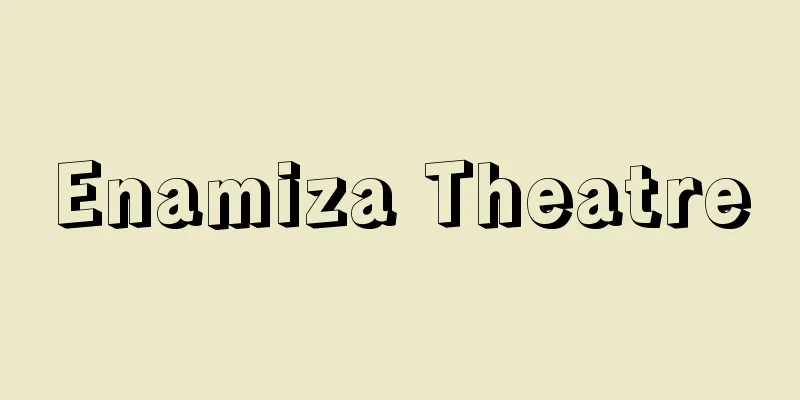Kamigata Dance

|
This is a unique type of Japanese dance that originated in the Kyoto-Osaka region. The type that developed in Kyoto is called "Kyomai". Kamigatamai is generally considered to be Kamigatamai, or Jiutamai, because it is primarily dance accompanied by Kamigata Jiuta (Jiuta). However, there are also dances to music other than Jiuta, so Kamigatamai refers to a wider range of dances, including Jiutamai. The term Kamigatamai was established after World War II by Yoshimura Yuki, who took into account the opinions of Hanayagi Shotaro, regarding Yoshimura-style dances accompanied by various types of music. While kabuki dance, which developed in Edo, is based on "dance," Kamigatamai is based on the tradition of "mai." Dance was incorporated into Kyoto-Osaka Kabuki during the Edo period, but there are almost no works from that old period left. The current version was developed in the late Edo period and later as a form of zashiki-mai (traditional Japanese room dance) incorporating techniques from Nohgaku, Gotenmai (a style of dance loved by nobles, feudal lords, and samurai families), puppets from Bunraku puppet theater, and Kabuki dance. Each school has a different origin, which is what gives each school its own unique characteristics. The Osaka Yamamura school has a strong Kabuki influence, since the founder was active as a choreographer for Kyoto and Osaka Kabuki, while he also created Zashikimai and Jiutamai and became the founder of the school. The Inoue school of Kyomai also has a charm that nods to this history, as the founder served a nobleman and mastered Shirabyoshimai and Kusemai to become a leading school, and the second generation and later had a particularly strong connection with Nohgaku. Even when the founder is a man, as in the Yamamura school, the tradition is mainly carried out by female dancers. This can be said to be a descendant of the Shirabyoshimai, Onna Kusemai, and Onnamai of the Middle Ages. The content of the works also stands out, as they sing of the circumstances and feelings of women. They also developed static techniques with a narrow range of movement, such as dancing within a single tatami mat in a room, and the "furi" has a strong symbolic flavor. This contrasts with the dynamic, concrete movements and showy performance style of Kabuki dance, which is perfected on stage. However, there are dances that feature dynamic techniques; they do exist. The repertoire includes representative jiuta pieces from Noh, such as "Kanawa," "Aoi no Ue," "Tamatori Ama," and "Yashima," as well as jiuta pieces from Kabuki dance, such as "Edo Miyage" and "Kanega Misaki," and pieces from Bunraku puppet theater, such as "Oguri's Horse-Training Tale," "The Talking Mountain Witch," and "Imoseyama Koi no Michiyuki." Conversely, the jiuta piece "Echigo Lion" is the original song for the famous Nagauta Kabuki dance. Jiuta end songs such as "Yuki," "Kurokami," and "Kosunoto" have a lustrous flavor, the memorial song "Sodekoro" has a solemn and quiet charm, and the Sakumono (comedic) songs "Nezumi no michiyuki" and "Arainezumi" are characterized by their interesting style. In addition to these, there are also Edouta (nagauta), Tokiwazu, Kiyomoto, Itchu-bushi, and Ogie-bushi. In recent years, various rare songs and new choreography have been presented. Among the schools of Kamigatamai, the Shinozuka-ryu, which was the leading school during the Bunka period (1804-18), was very popular, but it declined in the mid-Meiji period and has not been particularly active in recent years. Currently, the main schools are the Inoue-ryu school of Kyomai, the Yoshimura-ryu, which was founded in Osaka by a school founder who had mastered Kyomai, the Yamamura-ryu, which is pure Osaka, and the Umemoto-ryu, which developed in Osaka. Other schools include the Matsumoto-ryu Gotenmai and the Kanzaki-ryu. Takehara Han, who established his own unique style based on the Yamamura-ryu, is also well-known and was a dancer who lived in Tokyo along with the late head of the Kanzaki-ryu, Kanzaki Hide. [Kisaragi Aoko] [References] | | | | |Source: Shogakukan Encyclopedia Nipponica About Encyclopedia Nipponica Information | Legend |
|
日本舞踊のうち京阪地方で生まれた独特の舞踊をいう。なお、このなかで京都において発達したものを「京舞(きょうまい)」とよぶ。上方舞は上方における地唄(じうた)(地歌(じうた))を伴奏とする舞、つまり「地唄舞」が主体になっているため、一般には上方舞すなわち地唄舞とみなされることが多い。しかし地唄以外の音楽による舞もあるので、上方舞は地唄舞を含む、より広範囲のものをいう。上方舞という呼び方は第二次世界大戦後、吉村雄輝が種々の音曲による吉村流の舞について、花柳(はなやぎ)章太郎の意見を入れて定めたものである。江戸で発展した歌舞伎(かぶき)舞踊が「踊(おどり)」を根底にしているのに対して、上方舞は「舞」の伝統を基盤にしている。舞は江戸時代になり京坂歌舞伎に入ったが、そうした古い時代の作品はほとんど残っていない。現行のものは江戸末期以降に、能楽の舞や、公家(くげ)・諸侯・武家で愛好された御殿舞(ごてんまい)、また人形浄瑠璃(じょうるり)の人形や歌舞伎舞踊などの技法を摂取し、座敷舞として仕上げたものである。各流派の成り立ちには相違があり、それが流派の特色につながっている。 大阪の山村流は、初世が京坂歌舞伎の振付師として活躍していた一方で、座敷舞、地唄舞をつくりあげ流祖となったので、歌舞伎色がやや濃い。また京舞の井上流は、初世が公家に仕えて白拍子舞(しらびょうしまい)や曲舞(くせまい)を修得して一流を成し、2世以降能楽との関連がとくに深かったのでやはりこの経緯をうなずかせる趣(おもむき)を備えている。なお、山村流のように流祖が男性である場合も、その伝承はおもに女性の舞手によりなされてきている。これは、中世の白拍子舞や、女曲舞、女舞の系統を引くものといえよう。作品の内容も女性の境遇や心情をうたったものが目だつ。また座敷の畳一畳(じょう)の中で舞うといった行動範囲の狭い、静的な技法が発達しており、「振(ふり)」にも象徴的な味わいが濃い。舞台で完成された歌舞伎舞踊が動的で具象的な振、はでな演出様式をとるのと対照的である。ただし、動的な技法を特色とする舞がないわけではなく、存在する。 演目には、能からのいわゆる本行物(ほんぎょうもの)として代表的なものに地唄『鉄輪(かなわ)』『葵上(あおいのうえ)』『珠取海士(たまとりあま)』『八島』など、歌舞伎舞踊からのものに地唄『江戸土産(えどみやげ)』『鐘ヶ岬(かねがみさき)』などがあり、また人形浄瑠璃(じょうるり)からの義太夫(ぎだゆう)『小栗(おぐり)曲馬物語』『しゃべり山姥(やまんば)』『妹背山恋道行(いもせやまこいのみちゆき)』などがある。また逆に、地唄『越後獅子(えちごじし)』は有名な長唄の歌舞伎舞踊の原曲である。地唄の端歌物『雪』『黒髪』『小簾(こす)の戸』などはつややかな味わいが、追善曲『袖香炉(そでこうろ)』はしんみりと静かな曲趣が、作物(さくもの)(おどけもの)の『鼠(ねずみ)の道行』『荒れ鼠』などは作風のおもしろさが特色である。これらのほか江戸唄(長唄)、常磐津(ときわず)、清元(きよもと)、一中(いっちゅう)節、荻江(おぎえ)節などの演目もある。近年は、稀曲(ききょく)、新作の振付け発表も種々行われている。 上方舞の流派では、文化(ぶんか)期(1804~18)に一流を成した京舞篠塚流(しのづかりゅう)が盛大であったが、明治中期に衰退し、近年も目だった活動はない。現在は京舞井上流、京舞を修得した流祖が大阪で創始した吉村流、大阪生粋の山村流、大阪で発展した楳茂都流(うめもとりゅう)が主で、ほかに御殿儛(ごてんまい)松本流や神崎(かんざき)流などがある。また、山村流をもとに独自の舞を確立した武原はんは著名で、故神崎流宗家神崎ひでとともに東京在住の舞手であった。 [如月青子] [参照項目] | | | | |出典 小学館 日本大百科全書(ニッポニカ)日本大百科全書(ニッポニカ)について 情報 | 凡例 |
<<: Kamikatsu [town] - Kamikatsu
Recommend
Fishing culture
A culture whose basic form is catching fish, shell...
Argentine Chaco - Argentine Chaco
…The Gran Chaco is a vast plain in the center of ...
Information Security
Information is fragile even when there is no mali...
Anti-corrosive paint (rust-preventive paint, rust-preventive paint) - Sabusodometoryou (English spelling) anti-corrosive coating
Paint that inhibits the progression of rust. It is...
Will-less person
...This is a state of lack of willpower and stami...
Industrial melanism
A phenomenon in which dark mutated individuals of...
Massalia
…The Phocaeans are said to have founded Marseille...
Big furnace - Ooro
...The reason why the tea ceremony places such im...
The wise men
A scholar of the Sāvastāvatāda school of Indian Bu...
Kanso Jishū - Ten Poems for the Winter
…Poems such as “Five Boat Trips” (236), “Meeting ...
Brazilian edelweiss (English spelling)
... The main cultivated species are R. leuchotric...
Phasianus soemmerringii ijimae (English spelling) Phasianussoemmerringiiijimae
…[Ryozo Kakizawa]. … *Some of the terminology tha...
Autumn larch - Autumn larch
A large perennial plant of the Ranunculaceae fami...
Edge effect
In ecology, the effect of an organism being influe...
Monmousseau, G. (English spelling) MonmousseauG
...V. Griffour, the leader of the revolutionary f...









